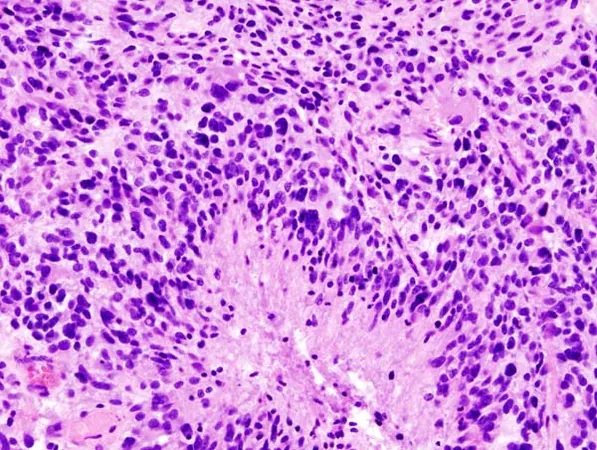
Revolutionary MRI Technology Offers Hope for Glioblastoma Patients
2024-09-30
Author: Sarah
Introduction
A groundbreaking study reveals that the innovative combination of MRI imaging and radiation therapy could transform the treatment landscape for glioblastoma patients, providing unprecedented insights into tumor progression in real time.
Study Overview
Conducted by researchers at the Sylvester Comprehensive Cancer Center, part of the University of Miami Miller School of Medicine, this research is the first to quantitatively assess tumor changes in glioblastoma patients undergoing MRI-guided radiation therapy. This pioneering approach, known as MRI-linear accelerator (MRI-linac), integrates daily imaging with radiation delivery, allowing doctors to closely monitor tumor dynamics. Sylvester holds the distinction of being the first cancer center to employ this technology for glioblastoma, and it remains one of the few facilities in the world utilizing this advanced method.
Key Findings
The findings, published on September 30 in the International Journal of Radiation Oncology—Biology—Physics and presented at the American Society for Radiation Oncology (ASTRO) meeting, highlight how daily MRIs can act as an early warning system, detecting tumor growth sooner than traditional imaging methods. Lead author Kaylie Cullison, Ph.D., emphasizes the potential of this technique to enable quick adjustments to treatment plans based on real-time monitoring.
Research Methodology
Under the leadership of Dr. Eric A. Mellon, a radiation oncologist and co-leader of Sylvester's Neurologic Cancer Site Disease Group, the study tracked 36 glioblastoma patients over a rigorous six-week regimen that included daily radiation therapy and MRI scans via MRI-linac. Researchers compared data from these daily observations with standard imaging protocols involving a single MRI with contrast performed a week prior to treatment and another month after its completion.
Advantages of MRI-linac
Traditional radiation protocols typically rely on X-ray or CT imaging to position patients, which lack insights into the brain’s internal conditions. “Any machine that does not include MRI, which comprises 99% of radiation-delivery equipment, cannot reveal internal brain conditions,” Dr. Mellon explained. The MRI-linac represents a major advancement in this regard, providing clarity previously unattainable in brain radiation therapy.
Results and Impact
The results were striking: for 74% of participants, the MRI-linac imaging correlated with traditional MRI assessments, accurately reflecting whether tumors increased, decreased, or remained unchanged during therapy. Meanwhile, 26% of patients exhibited discrepancies where the daily imaging indicated tumor growth, despite standard imaging showing a reduction. Notably, despite the occurrence of these inconsistencies, the MRI-linac did not miss any actual cases of tumor growth, suggesting its value as a diagnostic tool.
Optimizing Treatment
Moreover, beyond simply tracking tumor growth, the study indicates that such daily imaging could help optimize the radiation treatment area—narrowing it when tumors shrink, thus sparing healthy tissue from radiation exposure. This is particularly essential as glioblastoma patients often undergo surgery before radiation, leading to shrinking resection cavities which need to be monitored and adapted in treatment.
Future Research Directions
Mellon and his team are enthusiastic about pursuing future studies with MRI-linac to enhance treatment strategies not only for glioblastoma but potentially for various other brain cancers as well. Given the rarity of clinics that utilize such advanced technology for brain cancer treatment, the findings shed light on the significant changes glioblastomas undergo during the course of radiation, potentially paving the way for better patient outcomes in this aggressive and often fatal disease.
Conclusion
As researchers continue to explore this promising technology, glioblastoma patients may soon have a more tailored and effective treatment approach, bringing hope to those grappling with one of the most challenging forms of cancer.


 Brasil (PT)
Brasil (PT)
 Canada (EN)
Canada (EN)
 Chile (ES)
Chile (ES)
 España (ES)
España (ES)
 France (FR)
France (FR)
 Hong Kong (EN)
Hong Kong (EN)
 Italia (IT)
Italia (IT)
 日本 (JA)
日本 (JA)
 Magyarország (HU)
Magyarország (HU)
 Norge (NO)
Norge (NO)
 Polska (PL)
Polska (PL)
 Schweiz (DE)
Schweiz (DE)
 Singapore (EN)
Singapore (EN)
 Sverige (SV)
Sverige (SV)
 Suomi (FI)
Suomi (FI)
 Türkiye (TR)
Türkiye (TR)